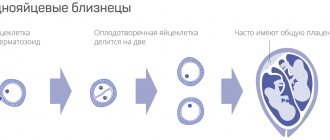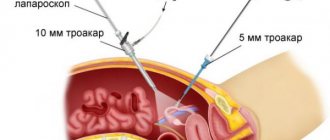Diagnostics
In case of involuntary termination of pregnancy, the two leading signs are: pain and bleeding.
Spontaneous miscarriages are characterized by their gradual course (stages of spontaneous abortion): threatened miscarriage, incipient miscarriage, ongoing abortion, incomplete and complete spontaneous miscarriage.
- Threatened miscarriage: bleeding can be very scanty, pain is either absent or has an aching, dull character in the lower abdomen. This condition is considered reversible, and with successful treatment, pregnancy develops normally in the future.
- Incipient miscarriage: bleeding may be slow, pain is cramping in nature. A threatened and incipient miscarriage occurs against the background of a completely satisfactory condition. Emergency measures to stop bleeding in these cases are usually not required. Hospitalization to a hospital is indicated, where the issue of maintaining the pregnancy and further treatment is decided. It is still possible to save the pregnancy, but the prognosis is worse than with a threatened abortion.
- Abortion in progress: bleeding is profuse, pain is cramping in nature; the general condition changes, which depends on the amount of blood loss. Urgent hospitalization is required. Preservation of pregnancy in this case is impossible; In the hospital, curettage of the uterine cavity and compensation of blood loss (depending on its volume) are performed.
- With incomplete spontaneous abortion, dark red discharge with clots can be significant. All this is accompanied by cramping pain in the lower abdomen. Emergency care consists of curettage of the uterine cavity and compensation of blood loss.
- Complete spontaneous miscarriage occurs more often in early pregnancy. The uterus contracts, the cervical canal closes and bleeding stops, since the fertilized egg is completely released from the uterus. No immediate assistance is required. In the hospital, a diagnostic curettage of the uterine cavity is performed to make sure there are no remains of the fertilized egg.
What are other symptoms of implantation in early pregnancy?
Since implantation bleeding only occurs in about a third of pregnancies, you'll likely be among the majority who don't experience it. However, your vigilance for the signs and symptoms of successful implantation is probably still massively high! So what are the other early signs that you might be pregnant? These may include:
Morning sickness
This can begin as early as 4 weeks after conception (10-14 days after embryo transfer), although it more often occurs around 6 weeks. Fortunately, for those who go through it, morning sickness is usually temporary and usually improves by 16 to 20 weeks of pregnancy.
Sensitivity to smells and tastes
Sudden sensitivity to smell and taste can be a sign of early pregnancy and undoubtedly contributes to ongoing stories about pregnant women's "cravings" for certain foods. Both increased sensitivity and morning sickness are the result of hormonal changes occurring in your body.
Frequent urination
It may seem strange when your baby is still very young, but the need to urinate more frequently in early pregnancy is one of the most common symptoms. It is also the result of hormonal changes that cause faster blood flow through the liver and kidneys to remove waste as efficiently as possible. In addition, the uterus quickly increases in size even at this early stage of pregnancy and therefore puts more pressure on the bladder, especially at night.
Breast tenderness
The well-known symptom of breast tenderness is another sign of early pregnancy. This is the result of an increase in blood flow and fluid retention in the mammary glands against the background of a sharp increase in the level of female sex hormones in the blood serum.
Stomach cramps
Cramping may occur on its own or be accompanied by slight bleeding, which may be a signal of implantation. You might think that all these possible early signs and symptoms of pregnancy would make it easy to be sure that it is happening. But the fact is that some symptoms are also present in some people as a precursor to their normal monthly cycle with premenstrual syndrome. So, despite all the possible clues, the only way to be sure of pregnancy is to take a pregnancy test and confirm the pregnancy with your doctor.
Hydatidiform mole
Hydatidiform mole is a peculiar change in the chorion, expressed in a sharp increase in the size of the villi, during which bubble-like expansions are formed. A hydatidiform mole can involve the entire chorion (complete hydatidiform mole) or part of it (partial hydatidiform mole). The risk group for the development of hydatidiform mole are women who have previously suffered hydatidiform mole, women with inflammatory diseases of the genitals and with disorders of the hormonal function of the ovaries. Usually observed in women aged 20-30 years.
With hydatidiform mole, there is a delay of menstruation by 2-3 months. and more, against the background of which bloody discharge appears caused by the rejection of mole bubbles. A characteristic discrepancy between the size of the uterus and the expected pregnancy period (the size of the uterus exceeds it). When the size of the uterus increases, corresponding to a gestation period of more than 20 weeks, the presence of a fetus in the uterus cannot be established even with the help of special diagnostic methods.
In contrast to a normal pregnancy, the symptoms of early toxicosis are much more pronounced. The most important criterion for diagnosing hydatidiform mole is the titer of human chorionic gonadotropin, which increases by more than a thousand times compared to a normal pregnancy.
Bleeding during a hydatidiform mole can be stopped in only one way - curettage of the uterine cavity.
After discharge from the hospital, careful observation is required in the antenatal clinic for 2 years with a systematic study of the reaction to the presence of human chorionic gonadotropin (every 3-4 months). If a negative reaction becomes positive, then urgent hospitalization is indicated to exclude chorionepithelioma, a malignant tumor that often develops after a hydatidiform mole (in the initial stages it grows slowly and is treatable).
Is implantation bleeding the same when you undergo IVF treatment?
People undergoing IVF or any other assisted fertility treatment often wonder whether pregnancy symptoms will be the same if embryo transfer and implantation are successful. In a word, yes. Although some stages of IVF are stimulated by medication, and although the actual joining of the egg and sperm occurs in a laboratory, the end result is identical.
Let's look at a summary of the steps that led to embryo implantation. The first step is ovarian stimulation, which causes the ovaries to produce a number of oocytes. Then, when the oocytes have reached a suitable stage of maturity, they are retrieved during ovarian puncture in order to then be fertilized with prepared sperm in an embryology laboratory. This is the point at which fertilization occurs and embryos are formed. They are cultivated - “grow” in special incubators and undergo the necessary tests (if genetic research of embryos is performed). The healthiest and most viable embryo is then transferred to the woman's uterus. This is, in a nutshell, the final stage of the process. Implantation of the embryo into the wall of the uterus after it has been transferred is not part of the assisted reproduction process; this is something that happens naturally in the same way as during normal conception. This final stage is not guaranteed as a result of IVF treatment, just as unprotected sex during ovulation is not guaranteed to result in pregnancy. This explains the absolute sameness of symptoms you can expect between assisted reproduction and natural pregnancy, including any implantation bleeding.
Cervical pregnancy
It is a variant of ectopic pregnancy. Cervical pregnancy is terminated in the early stages, most often before 12 weeks. Risk groups for the development of cervical pregnancy are women with a burdened obstetric history, who have suffered from inflammatory diseases, and diseases of the cervix. Bleeding during cervical pregnancy is always profuse, as the structure of the blood vessels of the uterus is disrupted; bleeding cannot be stopped without surgery. The only option to stop bleeding during cervical pregnancy is to remove the uterus without appendages, since the bleeding comes from the lower branches of the uterine artery.
What is implantation bleeding?
About 30-40% of women experience slight blood loss after the embryo implants in the uterus. This phenomenon is known as implantation bleeding. Since this happens early in your cycle, it may even be the first sign you realize you're pregnant. Bleeding usually occurs in the first weeks of pregnancy, since the uterus is an organ rich in blood vessels that can easily become damaged. When the embryo sticks to the inner wall of the uterus, the small veins and arteries that normally connect to the endometrium rupture and this can cause bleeding. If this occurs, usually 6-10 days after fertilization, it usually coincides with the theoretical date of menstruation and can therefore be confused with the onset of menstruation. There is no set pattern, and implantation bleeding may occur in one or all of a given person's pregnancies.
Cervical cancer
Cervical cancer in pregnant women is extremely rare, since most often this pathology develops in women over 40 years of age, in women with a history of many births and abortions, and in women who frequently change sexual partners. Conservative methods of stopping bleeding in cervical cancer are not used; only surgical treatment is indicated (depending on the stage of pregnancy).
Dear women, if you start bleeding, consult a doctor immediately. Gynecologists at the Complex Clinic have extensive experience and a professional approach to this problem.
The Complex Clinic has a special New Year's Promotion - a free initial appointment with a gynecologist.
Bleeding in the second half of pregnancy
While bleeding in the first half of pregnancy is associated with a risk of spontaneous miscarriage, in later stages it is most often associated with placental abnormalities.
- Premature placenta (placenta previa)
It occurs in 2–5% of pregnant women when the placenta is not positioned correctly. There are two types of bearings: full and partial. In the first case, scarlet bleeding without pain should be observed. In case of partial presentation, opening of the amniotic sac is indicated to correct the condition.
This pathology poses a threat to the expectant mother, as it can cause hemorrhagic shock. It also negatively affects the condition of the unborn child, increasing the risk of premature birth.
- Premature placental abruption
Always accompanied by bleeding. Placental abruption can cause placenta previa, multiple or large pregnancies, heart defects, physical trauma (fall), and abnormal development of the uterus. Women note the appearance of severe pain in the lower abdomen and increased tone of the uterus. The fetus suffers from hypoxia due to a lack of oxygen and other elements necessary for its development.
- Uterine rupture
Bright scarlet blood and severe pain in the lower abdomen indicate excessive stretching and thinning of the walls of the uterus, destruction of the muscle layer. This occurs when there are follicles or when there is scarring on the uterus from a previous cesarean section. Doctors recommend not getting pregnant after a cesarean section for at least two years.
- Bleeding from fetal vessels
This is a rare condition that occurs in no more than one child in 1000. It can be caused by a rupture of the umbilical cord or fetal membranes.
Bleeding in the second half of pregnancy is so dangerous that it can cause hemorrhagic shock in the mother, premature birth and the birth of a child with developmental defects.
Premature placental abruption
May occur after 16 weeks of pregnancy or during childbirth.
Causes
Diseases of the tissue (kidneys, heart and blood vessels), malformations of the uterus (bicornuate, septum), insufficiency of the corpus luteum, fetoplacental insufficiency, gestosis/toxicosis, polyhydramnios during real pregnancy and others.
What's happening
Small hematomas (containing blood inside) form between the placenta and the wall of the uterus, merging with each other and peeling the placenta away from the wall of the uterus.
Manifestations
With a small detachment, the bleeding is not abundant. Damaged vessels can thrombose (a blood clot forms) and further placental abruption is stopped.
When detachment occurs over a large area, bleeding is usually profuse.
Detachment is accompanied by increased uterine tone. There are nagging pains in the abdomen and lower back, sometimes they are quite pronounced and resemble pushing.
What threatens
Blood flows poorly to the child - the delivery of oxygen and nutrients is disrupted.
There is a risk of developing heavy bleeding, which threatens the life of both mother and child.
Accumulated blood can serve as a substrate for infection and/or lead to premature rupture of the membranes.
Read more - Leakage of amniotic fluid. Signs and diagnosis
Hypertonicity of the uterus during pregnancy











